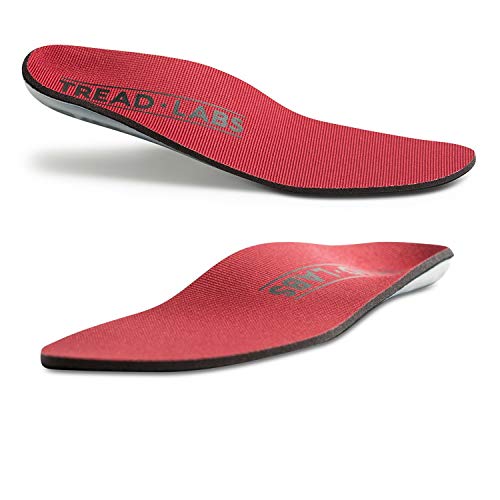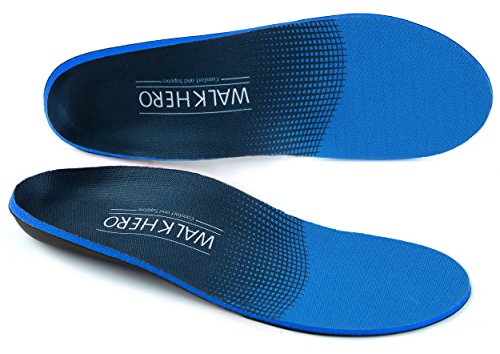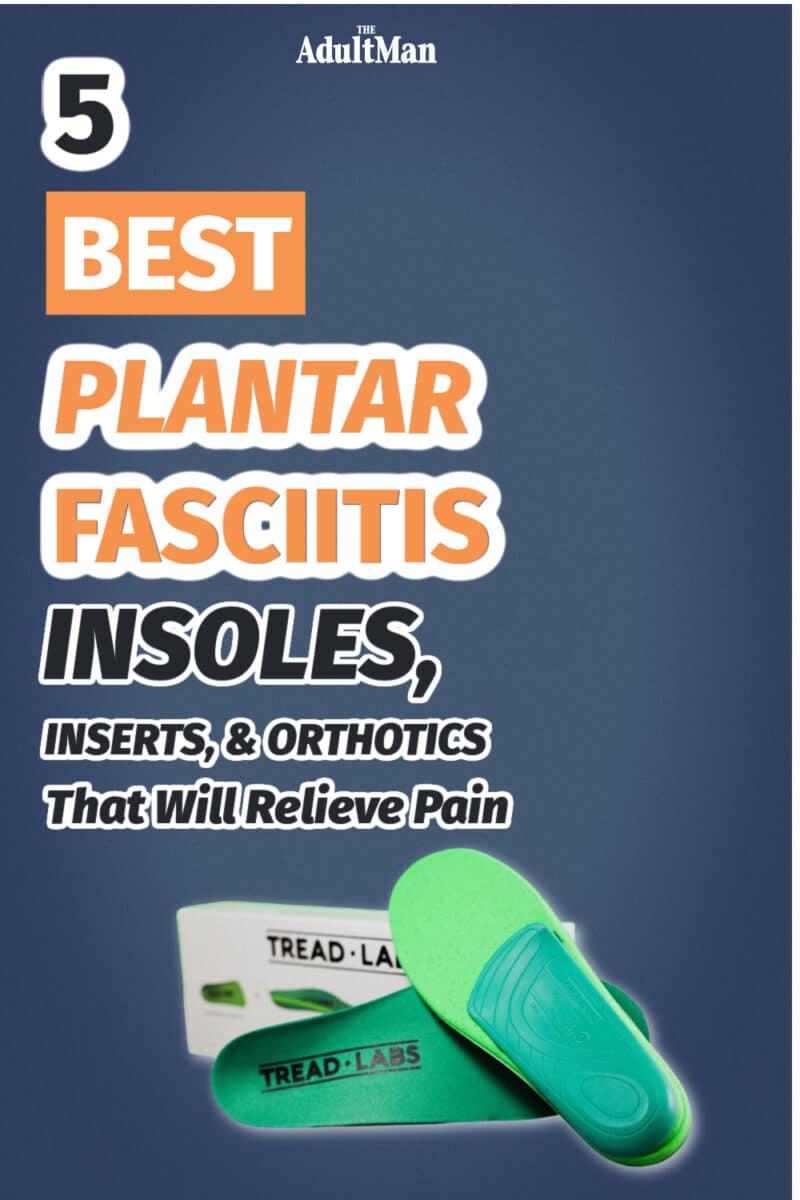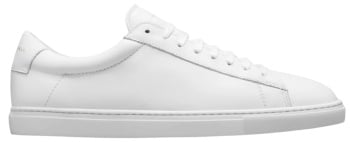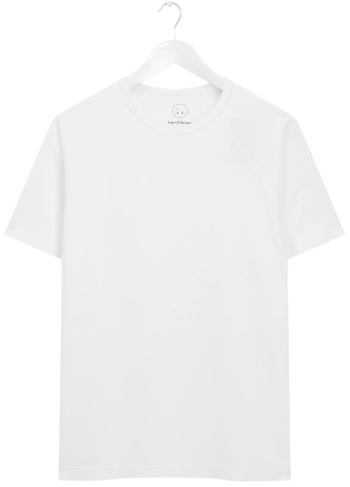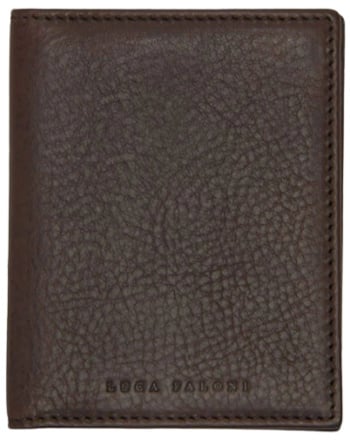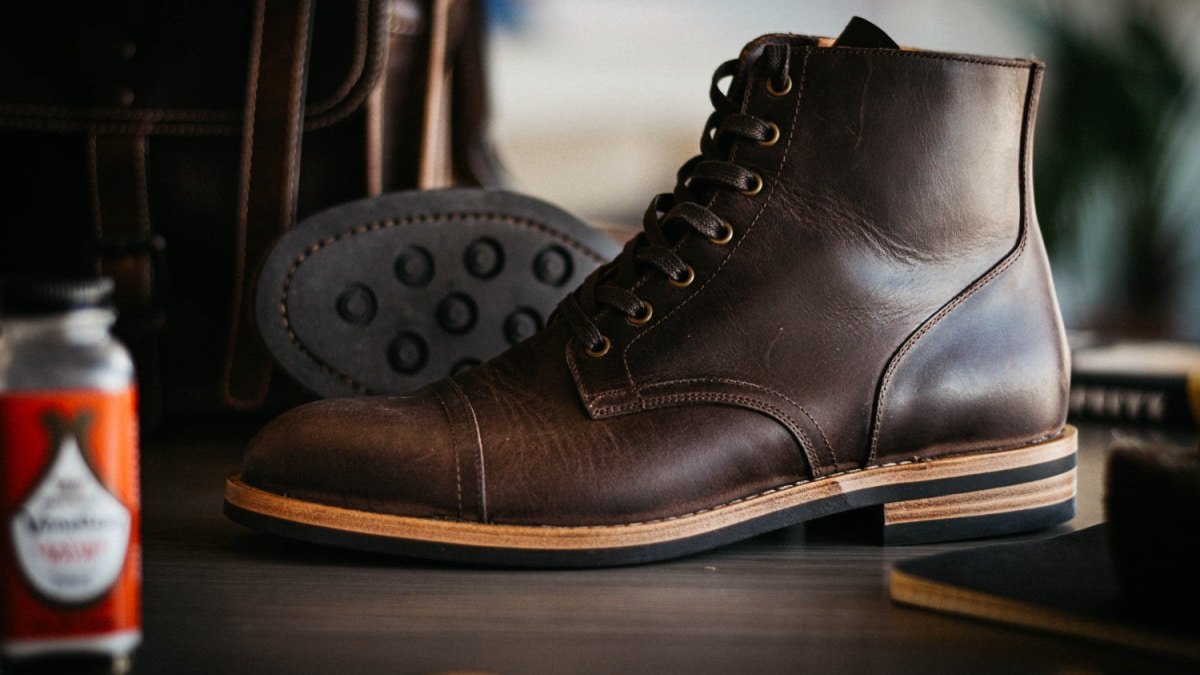Superfeet BLUEHere’s a question.
Do you know the structure of your feet?
Oh, no—this isn’t some kind of fetish thing.
I’m asking because I only recently found out this little nugget of information about myself. By the way, the easiest way to find out is to wet your foot and stand on a paper bag.
And because I just know you’re on the edge of your chair in anticipation, I can exclusively reveal (only on TAM!) that I have high-arched feet.
‘Yeah right-o Dean, what’s the point?’
Well, after ramping up the distance on my runs a few months ago (and the amount of GaryVee podcasts I got through), I started to feel some pain on the bottom of my left heel the next morning.
And after a super brainy “why does the bottom of my heel hurt?” Google search, I was introduced to the world of plantar fasciitis.
I now know that for me, the problem was a combination of shocking my feet with a lot more running suddenly (mostly on hard surfaces I might add) and my overly high-arched feet (thanks Mom and Dad).
And I know this, because since picking up a pair of semi-custom inserts, the frequency of my pain has reduced dramatically.
Skip Ahead
What is Plantar Fasciitis?
Plantar fasciitis (fashy-EYE-tis) is an inflammation of the plantar fascia ligament—a thick band of tissue that connects your heel to your toes.

And if you’re here, I probably don’t need to tell you that it causes pain in your foot. You usually feel it in the bottom of your heel, but for some people, it’s in the bottom mid-foot area.
Plantar Fasciitis commonly causes a sharp pain that you feel with your first steps after you wake up in the morning. The pain generally subsides as you move around, but it may return after long periods of standing or sitting still.
What Causes It?
Normally, your plantar fascia ligament supports the arch in your foot with all the shock-absorbing prowess of a bowstring. But whether intentional or not, if you get all Legolas in LOTR on that bowstring, small tears can arise and ultimately lead to your fascia becoming irritated or inflamed.
Even so, often it’s tough to pin down the exact cause of plantar fasciitis for any one individual. But here are a few things that may contribute to you developing it:
Being overweight. Excess weight increases pressure on your plantar fascia ligaments. Particularly if the weight gain is sudden. It’s for this reason that pregnant women often experience it in the later stages of their term.
Long-distance running or having an active occupation. The more active you are on your feet, the more likely you are to place strain on your plantar fascia.
Having structural foot problems. If you’re a guy with very flat feet or if they’re high-arched, you may be more likely to develop plantar fasciitis.
Wearing shoes with inadequate support. Ever walked around all day in shoes that are too small for you? I bet it’s nowhere near the top of your ‘awesome feelings’ list. Well your plantar fascia ligament wishes you’d stop doing it also. Wearing shoes that don’t fit correctly or that have poor support can stretch it and cause tension. And it sometimes leads to plantar fasciitis.
How Do You Cure Plantar Fasciitis?
Here are a few simple remedies you should consider to recover from plantar fasciitis, ease pain, and reduce the chance of it developing:
- Wear orthotic insoles specifically designed to treat plantar fasciitis, such as those listed below (click here to jump ahead);
- Perform specific exercises and stretches to strengthen your lower leg muscles which will then stabilize your ankle and heel;
- Lose weight to reduce the strain on your plantar fascia;
- Wear supportive shoes with good arch support and shock absorbency, and stop wearing those crappy shoes you’ve been trudging around in for years. If you’re a runner, invest in a new, quality pair of athletic shoes after every 400 miles of use;
- Apply ice and rest.
If symptoms persist after several months, get yourself to a doctor. They may recommend more serious treatments such as injections, shock wave therapy, a tenex procedure, or in rare cases, surgery.
What to Look For in Plantar Fasciitis Insoles
One of the simplest ways to relieve your foot pain as well as treat and prevent plantar fasciitis is to use plantar fasciitis insoles.
But it’s important you pick up a pair that are designed to actually be effective. Otherwise you may as well throw a sheet of cardboard in your shoes. It’ll do the same thing (i.e. nothing) but it’ll be a whole lot cheaper.
These are the most important qualities you should be looking for:
Tailored fit. Precision equals comfort in the insole game. You want to find a pair of insoles that are as close to custom fitting as possible. This means matching with the contours of the bottom of your foot. To achieve this, choose an insole that offers a range of arch heights (the more the better).
Strong foot support. As a general rule, the cheaper and more soft an insert is, the less likely it is to offer the support you need for plantar fasciitis. The better orthotic inserts use a strong molded arch made up of plastic or another solid material to offer the arch support you effectively need.
Durable cushioning. This may come as a shock, but our caveman ancestors weren’t scurrying between their office and Starbucks all day. Much like our bodies aren’t designed to ingest Coca Cola, our heels aren’t made for the hard surfaces we subject them to today. Look for an insole that combines firm arch support with a cushioned layer of foam on top for comfort.
Deep heel seat. Finally, look for an insole with a deep heel seat. The cupping effect this creates helps make the soft tissues around your heel more effective at cushioning impact to your heel bone. Yep, I’m talking about shock absorption. Oh, and it’ll also make your foot more stable which will improve your balance when playing sport.
The 4 Best Shoe Inserts for Plantar Fasciitis
1. Stride Insoles By Tread Labs

Comfort is the name of the game for Massachusetts based semi-custom insole brand, Tread Labs. And if you know anything about founder Mark Paigen’s story, you’ll understand why.
After almost 30 years of designing shoes and sandals with Shoestring Cobblers and Chaco Sandles respectively (you may have seen the popular Chaco Z/1 collection getting around), Mark decided to take his focus on comfort and quality to his own insole company.
Unlike other generic or semi-custom insoles, Tread Labs’ insoles are split into two separate parts. The base is a firm, dynamic arch support. And above it is a durable and replaceable top cover with PURE antimicrobial technology.

Another major point of difference of the Stride insoles compared to other insoles I’ve researched is that they’re available in multiple arch heights (four to be exact). And when you think about it, this makes sense. Especially now that I know about my whack super high-arched feet.
This choice allows you to get much closer to a custom fit (without the custom fit price tag). Naturally, it also makes them more effective in relieving plantar fasciitis and other foot related pain.

Other features include the Stride’s gentle but firm support which is designed to prevent overpronation related fatigue, and deep heel cups for better shock-absorption.
Pros
- Fantastic warranty and support. All products can be returned within 30 days with free shipping both ways. Lifetime guarantee on the arch supports.
- Being able to choose your arch height has a hugely positive impact on comfort. Great for both flat and high-arched feet.
- Replaceable top cover means you can easily reset your insoles to ‘out-of-the-box-new’ anytime you like.
- Consistently effective at providing plantar fasciitis relief across hundreds of reviews.
Cons
- Pricier than many generic options, but much less of a gamble when it comes to fit.
- The heel cup is quite narrow and may be uncomfortable for a select few. But you can always return them for free and get a full refund if so.
Get Them
Last update on 2022-01-06 / Affiliate links / Images from Amazon Product Advertising API
2. WalkHero Insoles
WalkHero is an insole developer and manufacturer with their sights set firmly on the budget conscious buyer.
And with over 500 Amazon reviews and a 4.3 rating, they’re clearly serving this market extremely well.
WalkHero’s insoles are designed for wider, high volume shoes, and they claim to have developed new technology to correct overpronation (i.e. flat feet). Boasting firm arch support, high mobility, and anti-microbial top fabric, the brand lists plantar fasciitis as one of several conditions the insole is ideal for.
As you’d expect given the price point, WalkHero don’t offer a choice of arch heights.
Pros
- They seem to work incredibly well for people with flat feet with many reviewers reporting a dramatic reduction in plantar fasciitis pain.
- Great value for money.
- Fit nicely inside a wide range of shoe type.
Cons
- The ‘one shape fits all’ build may not provide enough support for people with overly high-arched feet.
- Several reviewers reported durability issues.
- Not a lot of cushioning on the heel seat.
Get Them
Last update on 2022-01-06 / Affiliate links / Images from Amazon Product Advertising API
3. Powerstep Pinnacle Insoles
Founded in 1991 by a podiatrist, foot surgeon, and runner (what an orthotic combo that is), Powerstep is a well-known producer of orthotics. Their most popular product is their mid-range insole, the Powerstep Pinnacle.
Designed for mild to moderate pronators, the Powerstep Pinnacle features an EVA foam base, cushioned top layer, built in arch support and a deep heel cradle.
Like all inserts I’ve included on this list, they claim to have been specifically designed to relieve pain associated with plantar fasciitis (and other foot issues).
While the Powerstep Pinnacle also doesn’t offer (it’s a sub $40 insole after all) a choice of arch height, they purport to have a versatile insole which is suitable for all arch heights and a wide variety of shoe types (provided they have removable insoles).
Pros
- Work particularly well for wide and/or flat feet.
- Many plantar fasciitis suffers claimed a vast reduction in pain.
- Fit well inside most shoe types.
Cons
- Small heel cup with limited cushioning in the heel which may make it less stable than more expensive options.
- Thin with not a lot of padding overall.
- May not have great longevity—several reviewers complained about the insole rapidly degrading, some cases within days, and others within a year of purchase.
Get Them
Last update on 2022-01-06 / Affiliate links / Images from Amazon Product Advertising API
4. Superfeet Insoles
Superfeet have taken on the insole space a little differently. The brand has developed color-coded range of insoles, with each color representing a different style and arch size.
Their most popular seller, the Superfeet BLUE (medium arch), is made from latex-free and vegan antibacterial coating, and high-density closed-cell foam for added comfort.
Like other insoles we’ve researched and featured here, the Superfeet BLUE boasts a heel cup and odor-control coating for bacteria-elimination.
Pros
- Comfortable, well designed, and colorful.
- Multiple arch heights available.
- They cup your heel and support your ankle without damaging your shoes like some other insole styles.
- Multiple reviewers have stated positive improvement in their feet and ankles (including for plantar fasciitis), as well as knees, back and spine, and overall body.
Cons
- Sizing can be difficult to determine.
- Some reviewers state they aren’t as durable as they are made out to be.
- Product is non-refundable.
Get Them
Last update on 2022-01-06 / Affiliate links / Images from Amazon Product Advertising API
Conclusion
I think insoles are like good quality headphones.
After one use you’re now aware that the promise land is out there. And it’s a real struggle to go back.
Whether that’s to your crappy $3 earbuds, or to your non-insole mediocrity.
Have you tried any of these insoles for yourself? Chat with me about it in the comments. I’d love to hear your thoughts on these, or any other insoles I should check out.
Oh, and more importantly—do you know the structure of your feet yet?

